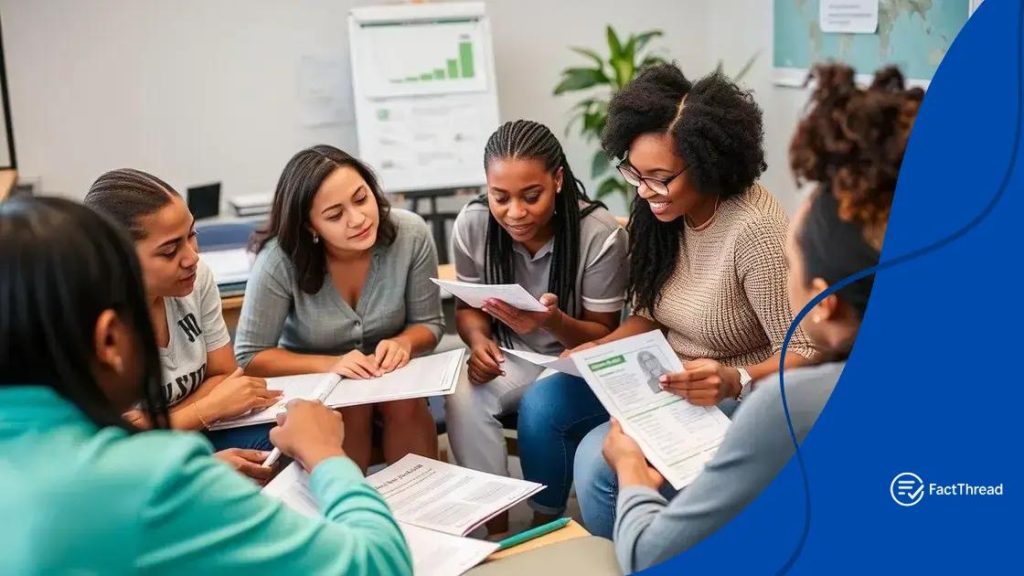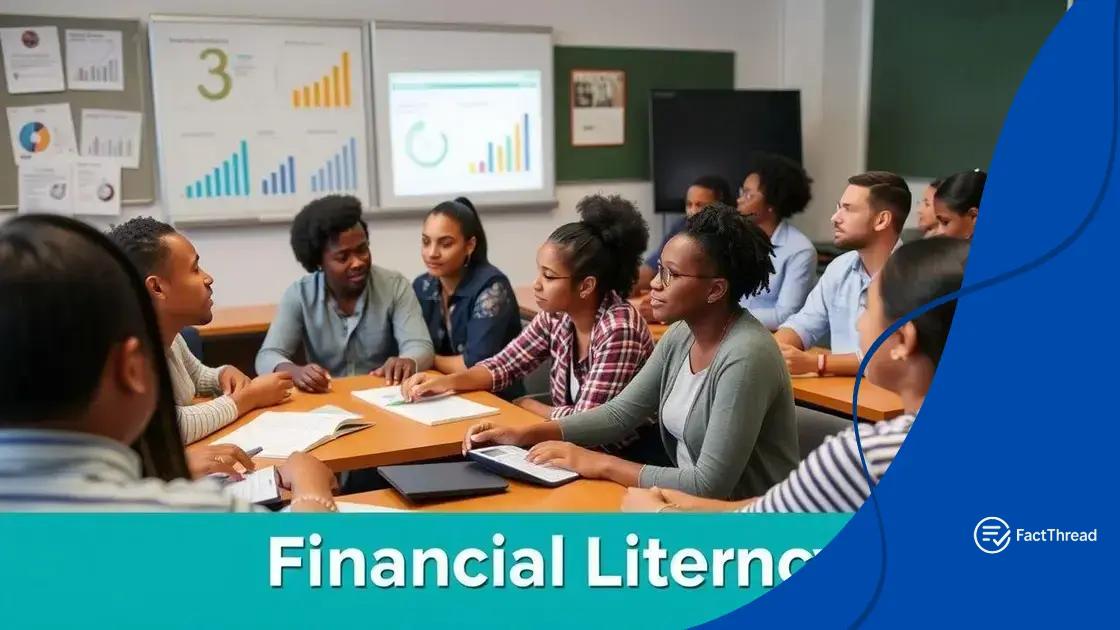Financial literacy education initiatives expand opportunities

Financial literacy education initiatives expand access to essential knowledge, enabling individuals to make informed financial decisions and significantly improving community well-being and economic growth.
Financial literacy education initiatives expand access to crucial knowledge, benefiting individuals and communities alike. Have you considered how these programs can transform lives?
Understanding financial literacy education
Understanding financial literacy education is crucial for everyone, regardless of age or background. It provides individuals with the knowledge to make informed financial decisions. This means learning about budgeting, saving, investing, and managing debt effectively.
What is Financial Literacy?
Financial literacy refers to the ability to understand and effectively use various financial skills. It encompasses a range of topics, including:
- Budgeting: Creating a plan on how to spend money.
- Saving: Setting aside money for future needs.
- Investing: Allocating resources to earn returns over time.
- Debt management: Understanding how to manage borrowed money responsibly.
These components are fundamental in today’s economy, where financial decisions have a significant impact on one’s quality of life. People who are educated in these areas can avoid common financial pitfalls.
The Importance of Financial Literacy Education
Financial literacy education can lead to better financial outcomes for individuals and families. It helps them make smarter choices and avoid costly mistakes. Additionally, this education fosters a sense of self-confidence when dealing with money. Those who understand their finances are more likely to:
- Plan for retirement: Saving adequately for the future.
- Avoid debt traps: Steering clear of high-interest loans.
- Invest wisely: Selecting the right investment opportunities.
When financial education is prioritized, entire communities benefit. People become empowered to break the cycle of poverty and improve their overall wellbeing.
The role of initiatives in community development
The role of initiatives in community development is vital for fostering financial literacy. These initiatives not only educate but also empower individuals to make sound financial decisions. By providing accessible resources, communities can thrive financially.
How Initiatives Foster Economic Growth
Community development initiatives lead to better economic outcomes by promoting skills and knowledge. They provide workshops, seminars, and hands-on training in various financial topics. Participants are often guided through:
- Budgeting skills: Learning to plan expenses and savings.
- Investment strategies: Understanding how to grow wealth.
- Debt management: Finding ways to reduce or eliminate debt burdens.
When these initiatives succeed, the benefits ripple out. People learn to navigate their finances effectively, thus reducing stress and building financial resilience.
Community Empowerment Through Education
Financial education initiatives help communities empower themselves. When residents gain skills, they often share this knowledge, creating a culture of support and learning. This dynamic shifts the community’s focus toward:
- Collective growth: Working together to achieve financial goals.
- Resource sharing: Helping one another in understanding financial concepts.
- Networking opportunities: Connecting individuals with experts in finance.
As residents become more informed, they can advocate for better financial policies and services. This collective voice strengthens the community and attracts further resources.
Key benefits of financial literacy programs

Key benefits of financial literacy programs extend far beyond just understanding money. These programs empower individuals with the skills needed to make informed financial decisions. By participating, people can significantly improve their financial well-being and quality of life.
Improved Financial Decision-Making
One of the most critical advantages of financial literacy programs is the ability to make better financial choices. Participants learn about budgeting, investing, and saving. This knowledge equips them to:
- Create effective budgets: Knowing how to allocate money effectively.
- Make informed investments: Understanding where and how to invest.
- Manage debts wisely: Tackling debts with confidence and strategies.
These skills can lead to long-term financial stability and help individuals avoid common pitfalls.
Increased Financial Confidence
Participating in financial literacy programs can boost an individual’s confidence when dealing with money. As they gain knowledge, they feel more secure in their decisions. This confidence can manifest in various ways, including:
- Negotiating salaries: Feeling empowered to ask for better pay.
- Making larger purchases: Understanding financing options for homes and cars.
- Planning for retirement: Preparing adequately for the future.
With increased confidence, individuals are more likely to take control of their financial futures.
Community Impact and Growth
Financial literacy programs not only benefit individuals but also have a broader impact on communities. When residents understand finance, they contribute to the local economy. This leads to:
- Stronger local businesses: Better decision-making can lead to more successful entrepreneurs.
- Enhanced community planning: Informed citizens can participate in improving community resources.
- Lower poverty rates: Families can break the cycle of poverty through sound financial management.
Ultimately, as more people gain these financial skills, communities grow stronger and more prosperous.
How to get involved in local initiatives
Getting involved in local financial literacy initiatives can significantly impact both your life and your community. There are numerous ways to participate, whether as a learner, volunteer, or advocate. Engaging with these programs helps spread financial knowledge, which ultimately benefits everyone.
Finding Local Programs
The first step to getting involved is to find financial literacy programs in your area. Many organizations offer educational resources. You can:
- Check community centers: These often host workshops and classes.
- Visit local libraries: Many libraries provide free resources and sometimes host financial literacy events.
- Explore online platforms: Websites like Meetup or Eventbrite list local events and programs focused on financial literacy.
Connecting with people at these events can lead to further opportunities for involvement.
Volunteering Your Time
Another way to get involved is by volunteering. Many financial literacy programs rely on volunteers to facilitate workshops or mentor participants. By volunteering, you can:
- Share your expertise: If you have knowledge in finance, teaching can be immensely rewarding.
- Help others: Your time can help individuals learn essential financial skills.
- Expand your network: Volunteering connects you with like-minded individuals and professionals in the community.
These experiences can also enhance your own financial understanding as you teach others.
Advocating for Financial Education
Getting involved isn’t limited to workshops and volunteering. Advocating for financial literacy in your community is crucial. You can:
- Raise awareness: Talk about the importance of financial literacy in schools and organizations.
- Engage with local leaders: Discuss the need for more resources and support for financial education initiatives.
- Share success stories: Show how financial literacy has positively changed lives in your community.
By advocating, you contribute to creating a culture that values financial education.
Measuring the impact of financial literacy education
Measuring the impact of financial literacy education is essential for understanding how effectively these programs work. To ensure they bring real change, it’s important to evaluate several key factors. By doing this, organizations can improve their offerings and reach more individuals.
Assessment Methods
Different methods can be used to assess the effectiveness of financial literacy programs. Evaluators might consider:
- Pre- and post-tests: Measuring knowledge before and after a program gives clear insights into learning improvements.
- Surveys and feedback: Collecting participant feedback can highlight areas of success and opportunities for growth.
- Long-term follow-up: Tracking participants after several months or years can show if skills are applied over time.
These methods help create a better understanding of how effective the education truly is.
Key Indicators of Success
There are several indicators that can illustrate the success of financial literacy education. Some key factors include:
- Increased savings rates: Participants may begin saving a higher percentage of their income.
- Improved credit scores: Understanding credit can lead to better financial habits and higher credit ratings.
- Debt reduction: Programs that promote budgeting and responsible spending often see participants reduce their overall debt levels.
These indicators provide clear data showing the positive effects of financial education.
Community-Level Changes
The impact of financial literacy education also extends to the community level. As more individuals become financially literate, communities often experience:
- Economic growth: With better financial decisions, local economies can thrive.
- Increased employment opportunities: Individuals can use their skills to find better jobs or create businesses.
- Lower poverty rates: Financially educated individuals are often better equipped to improve their economic situations.
Evaluating these changes is vital for demonstrating the broader effects of financial literacy initiatives.
FAQ – Frequently Asked Questions About Financial Literacy Education
What is financial literacy education?
Financial literacy education teaches individuals the skills needed to manage their finances effectively, including budgeting, saving, investing, and understanding credit.
How can I get involved in financial literacy initiatives?
You can get involved by attending local workshops, volunteering to teach, or advocating for financial education programs in your community.
What are the benefits of financial literacy programs?
Financial literacy programs empower individuals to make informed financial decisions, which can lead to improved savings, better credit scores, and lower debt levels.
How do we measure the impact of financial literacy education?
Impact can be measured through assessments like pre- and post-tests, participant feedback, and observing changes in financial behaviors and community outcomes over time.